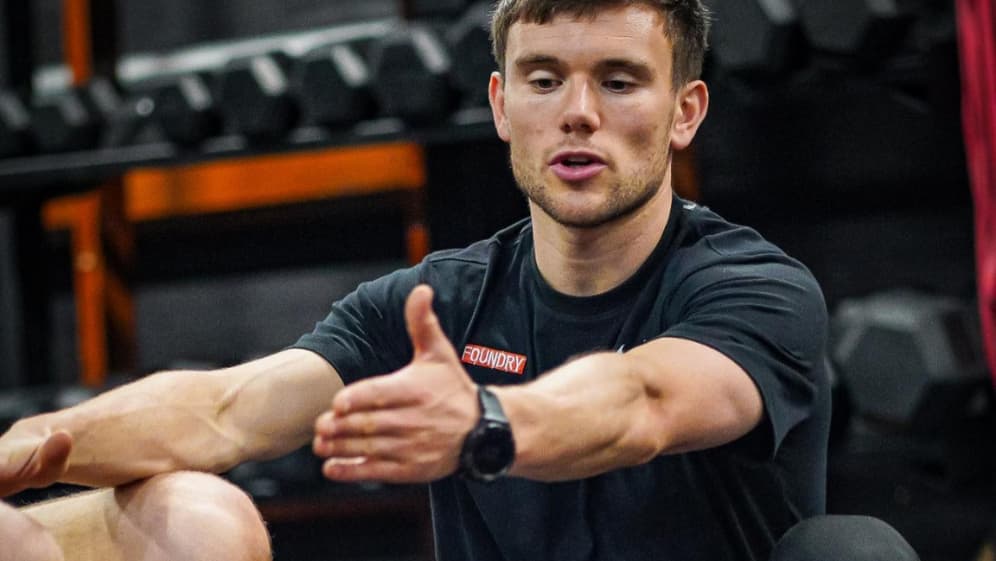Most people will reluctantly admit that warming up before training is essential. Sure, it’s not the most exciting part of your workout, and we’d all rather skip straight to lifting or hitting the machines. But if you’re serious about getting results and staying injury-free, it’s time to rethink your warm-up.
Warming up provides both physical and mental benefits. Physically, it increases heart rate, loosens the joints, and boosts muscle blood flow. Mentally, it gives you five to ten minutes to switch gears and focus on the workout ahead. Whether you use this time to visualise your lifts or wrap up the last bit of gym banter, setting yourself up for success is crucial.
Gone are the days when a warm-up consisted of five minutes on the treadmill, followed by half-hearted arm circles and leg swings. That approach just doesn’t cut it anymore. Today, we’re smarter about how we prepare the body for exercise. Enter Movement Prep (MP) — a more intentional and effective way to prime your body for action.
MP still delivers a traditional warm-up’s physiological and psychological benefits but goes further. It’s designed to mobilise joints, release tight muscles, activate underused muscles, and get your body ready to move in the ways your workout demands.
There are many ways to approach MP, and different methods work for different people depending on their goals. But at Foundry, we use a four-part system that covers all the bases:
The Movement Prep Sequence
Our MP process follows this sequence:
- Release
- Inhibit
- Activate
- Integrate
Let’s break it down:
-
Release
First, we want to target soft tissue (like muscles) to release any tight spots and prepare them for the stress ahead. This is where foam rolling comes in — think of it as a self-massage to loosen things up and check for any areas of tension that need extra attention.
At Foundry, we typically focus on key areas: the IT band (side of the leg), vastus lateralis (front of thigh), VMO/adductors (inner thigh), calves, hamstrings (back of thigh), glutes (your backside), thoracic spine (upper back), and lats (under the arm).
After foam rolling, we move on to more targeted work using a hockey or cricket ball. This technique zeroes in on specific trigger points — it’s like using a massage therapist’s elbow to dig into those tight, tender spots. Common areas we hit include the glutes, plantar fascia (under the foot), calves, and pecs (chest).
Note: Foam rolling and trigger-point work can be uncomfortable. Soreness is normal (even a good sign), but sharp pain means you must ease off.
-
Inhibit
Many of us spend our days sitting, and our bodies adapt to this posture. This often leads to overactivity or shortened muscles that must be stretched out before moving. In other words, we need to inhibit these muscles so they don’t dominate our movements and throw everything out of whack.
Typical culprits include the neck extensors (back of the neck), upper traps (shoulders), pecs (chest), lats, hip flexors (front of the pelvis), hamstrings (behind the knee), and calf muscles. Stretching these areas helps to prevent them from taking over and lets their underactive counterparts do their part (more on that below).
-
Activate
Once we’ve inhibited the overactive muscles, it’s time to wake up the underactive ones. These muscles are often weaker or less engaged due to our everyday habits, and we need them firing on all cylinders when we move.
For example, if your pecs (chest) are overactive, your rhomboids and scapular retractors (mid-back) might be underactive. So, after inhibiting the strong muscles, we focus on activating the weaker ones that are often ignored. This ensures that everything is working together in balance when you start moving.
Common underactive areas include the neck flexors (front of the neck), mid/lower traps (mid-back), shoulder external rotators (back of the shoulder), and glutes.
-
Integrate
Finally, we need to tie it all together. Now that we’ve released tight spots, inhibited overactive muscles, and activated the underused ones, it’s time to move. This phase integrates your rebalanced system into functional movement patterns. Bodyweight exercises are a great way to reinforce these patterns and prepare for more intense activity.
The Bottom Line
Let’s face it: we don’t move as much — or as well — as we used to. A well-executed warm-up or movement prep routine can be the difference between staying injury-free and getting sidelined, between effective workouts and just going through the motions. If you’re not doing it already, now’s the time to start.
Everyone has unique needs, but applying these principles will help you get more from your training. Your joints, muscles, and future self will thank you.
If you have any questions about the above or would like some advice on how we could help you with your fitness goal, don’t hesitate to visit one of our Gyms in East London and try one of our small group personal training sessions.
Related Articles
- What Does a Foundry Warm Up Include?
- Exercise: The Wonder Drug You Need (and How to Get Started)
- The Mental Warm Up
- Anaerobic Exercise Advantage for Strength, Speed & Endurance
- Rethinking Personal Training with Foundry

